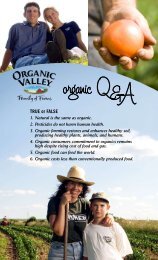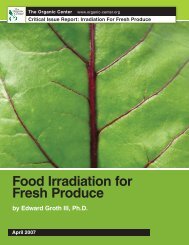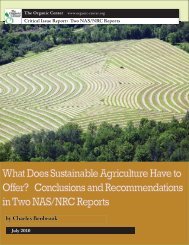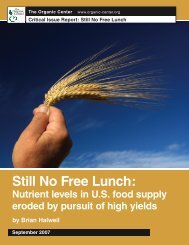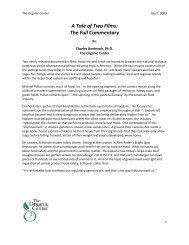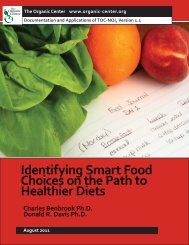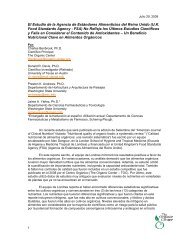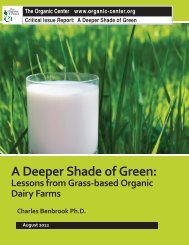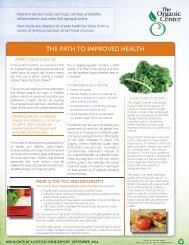Organoleptic Quality? - The Organic Center
Organoleptic Quality? - The Organic Center
Organoleptic Quality? - The Organic Center
You also want an ePaper? Increase the reach of your titles
YUMPU automatically turns print PDFs into web optimized ePapers that Google loves.
Taste of <strong>Organic</strong> Food <strong>The</strong> <strong>Organic</strong> <strong>Center</strong><br />
I. FOCUS STATEMENT<br />
This State of the Science Review attempts to answer thw question “Do organic fruits<br />
and vegetables taste better than conventional fruits and vegetables?”. <strong>The</strong>re are<br />
several reasons why this question should be addressed.<br />
First, 43% of consumers of organic food give “better taste” as a major reason for<br />
purchasing organic fruits and vegetables (MORI Poll 2001, cited by Heaton (Heaton,<br />
2001)). It is important to know if the consumer conviction of “better taste” is due<br />
solely to the “halo effect” 1 of the organic label, and, if not, what accounts for the<br />
often-cited claim that organic produce tastes better.<br />
Second, the levels of some phenolic compounds are known to be higher in organic fruits and vegetables<br />
(Benbrook, 2005). Plants create phenolic compounds for many reasons, but a major reason is to make plant<br />
tissues less attractive to herbivores, insects, and other predators. Some phenolic compounds actually taste<br />
bad (Drewnowski and Gomez-Carneros, 2000; Lesschaeve and Noble, 2005). <strong>The</strong> bitter taste and the tactile<br />
sensation of astringency in tea, cider, red wine, and chocolate are caused primarily by the flavonoid phenolics,<br />
including flavanols and flavonols (Lesschaeve and Noble, 2005). <strong>The</strong>se phenolic compounds, like those in red<br />
grapes, are often responsible for the unique flavor of certain fruits. Accordingly, it is important to sort out<br />
if higher levels of phenolic compounds affect the taste of organic fruits and vegetables when compared to<br />
conventionally grown produce.<br />
What Is “<strong>Organoleptic</strong> <strong>Quality</strong>?”<br />
<strong>The</strong> dictionary defines “organoleptic” as “of or pertaining to the sensory properties of a particular food or<br />
chemical.” <strong>Organoleptic</strong> quality includes the typical sensory properties of a food: its taste, appearance and<br />
color, aroma, size and firmness, and even sound (e.g., the “snap” or “crack”<br />
when biting into a crisp apple). But organoleptic measures also include mouth<br />
feel and any other sensations related to eating a food.<br />
<strong>The</strong> term organoleptic quality is used broadly in this document to include<br />
storage properties (“storability”), since many fruits and vegetables are stored<br />
for various periods of time to enable “non-seasonal” retail availability. Clearly,<br />
produce that stores well will be more appealing to consumers than fruit with<br />
visible blemishes, soft spots, or lack of flavor. <strong>Organic</strong> cultivation practices can<br />
influence storability and thus alter the organoleptic qualities of produce at the<br />
point of sale and consumption.<br />
1 “Halo effect” is the term used to describe cognitive bias that arises when information about one quality<br />
attribute of a product serves to influence and bias the judgment of its other qualities.



